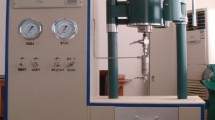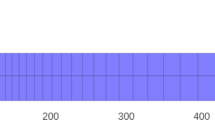Abstract
Underbalanced drilling performances have always considered as one of the proper solutions to prevent the formation damage problems during the drilling operational performances. To numerically model the spontaneous counter-current imbibition during the underbalanced drilling operational performances, different imbibition mechanism in the porous media should be taken into consideration. In this paper, a developed numerical approach was proposed to evaluate the various parameters which significantly affected the formation damage caused by underbalanced drilling performances. To verify the accuracy of the proposed model, which is analytically modeled by implicit pressure explicit saturation (henceforth; IMPES), a set of experimental CT scan data from a laboratory pilot was administered. Subsequently, the proposed analytical model is in a good agreement with CT scan laboratory data which clearly indicated the reliability of the model to evaluate filtrated mud saturation.





Similar content being viewed by others
Abbreviations
- φ :
-
Cross-section porosity (%)
- \({\text{CT}}_{\text{brine}}^{\text{sat}}\) :
-
Number of CT with 100% salty water saturation (dimensionless)
- \({\text{CT}}_{\text{co2}}^{\text{sat}}\) :
-
Number of complete saturation of cores with carbon dioxide (dimensionless)
- \({\text{CT}}_{\exp }\) :
-
Number of cores after flooding (dimensionless)
- \({\text{CT}}_{\text{brine}}\) :
-
Number of salty water (dimensionless)
- \({\text{CT}}_{\text{air}}\) :
-
The air number (dimensionless)
- μ :
-
The damping factor of gamma rays
- \(S_{\text{w}}\) :
-
Water saturation (%)
- k :
-
Absolute permeability of the porous medium (mD)
- \(k_{\text{r}}\) :
-
Relative permeability of each phase (dimensionless)
- \(P_{\text{c}}\) :
-
Capillary pressure of the rock (psi)
- \(k_{\text{rw}}^{0}\) :
-
Water maximum relative permeability (dimensionless)
- \(k_{\text{ro}}^{0}\) :
-
Oil maximum relative permeability (dimensionless)
- B :
-
Capillary pressure parameter (dimensionless)
- \(D_{\text{m}}\) :
-
The maximum value of the penetration coefficient (dimensionless)
- c :
-
Coefficients of the penetration (dimensionless)
- n :
-
Coefficients of the penetration (dimensionless)
References
Ahammad, M., Rahman, M., Zheng, L., et al. (2018). Numerical investigation of two-phase fluid flow in a perforation tunnel. Journal of Natural Gas Science and Engineering,55, 606–611.
Akin, S., & Kovscek, A. (1999). Imbibition studies of low-permeability porous media. In SPE western regional meeting. Society of Petroleum Engineers.
Baldino, S., Miska, S. Z., & Ozbayoglu, E. M. (2018). A novel approach to borehole-breathing investigation in naturally fractured formations. In SPE drilling & completion.
Bazyari, A., Soulgani, B. S., Jamialahmadi, M., et al. (2018). Performance of smart water in clay-rich sandstones: Experimental and theoretical analysis. Energy & Fuels,32, 10354–10366.
Bello, O., Perozo, N., Huseynov, P., et al. (2018). A simplified framework and performance analysis for while-drilling telemetry systems in underbalanced drilling operations. Environmental Earth Sciences,77, 512.
Boujelben, A., McDougall, S., Watson, M., et al. (2018). Pore network modelling of low salinity water injection under unsteady-state flow conditions. Journal of Petroleum Science and Engineering,165, 462–476.
Broens, M., & Unsal, E. (2018). Emulsification kinetics during quasi-miscible flow in dead-end pores. Advances in Water Resources,113, 13–22.
Cao, S. C., Jang, J., Jung, J., et al. (2018). 2D micromodel study of clogging behavior of fine-grained particles associated with gas hydrate production in NGHP-02 gas hydrate reservoir sediments. Marine and Petroleum Geology.
Chen, S., Zhang, D., Shang, T., et al. (2018). Experimental study of the microstructural evolution of glauberite and its weakening mechanism under the effect of thermal-hydrological-chemical coupling. Processes,6, 99.
Cheng, Z., Wang, Q., Ning, Z., et al. (2018). Experimental investigation of countercurrent spontaneous imbibition in tight sandstone using nuclear magnetic resonance. Energy & Fuels,32, 6507–6517.
Davarpanah, A. (2018a). Feasible analysis of reusing flowback produced water in the operational performances of oil reservoirs. Environmental Science and Pollution Research,25, 35387–35395.
Davarpanah, A. (2018b). A feasible visual investigation for associative foam > \ polymer injectivity performances in the oil recovery enhancement. European Polymer Journal,105, 405–411.
Davarpanah, A. (2018c). The feasible visual laboratory investigation of formate fluids on the rheological properties of a shale formation. International Journal of Environmental Science and Technology. https://doi.org/10.1007/s13762-018-1877-6.
Davarpanah, A. (2018d). The integrated feasibility analysis of water reuse management in the petroleum exploration performances of unconventional shale reservoirs. Applied Water Science,8, 75.
Davarpanah, A., Akbari, E., Doudman-Kushki, M., et al. (2019). Simultaneous feasible injectivity of foam and hydrolyzed polyacrylamide to optimize the oil recovery enhancement. Energy Exploration & Exploitation,37, 44–59.
Davarpanah, A., & Mirshekari, B. (2018). A simulation study to control the oil production rate of oil-rim reservoir under different injectivity scenarios. Energy Reports,4, 664–670.
Davarpanah, A., & Mirshekari, B. (2019). Mathematical modeling of injectivity damage with oil droplets in the waste produced water re-injection of the linear flow. The European Physical Journal Plus,134(4), 180. https://doi.org/10.1140/epjp/i2019-12546-9.
Davarpanah, A., Mirshekari, B., Jafari Behbahani, T., et al. (2018a). Integrated production logging tools approach for convenient experimental individual layer permeability measurements in a multi-layered fractured reservoir. Journal of Petroleum Exploration and Production Technology,8, 743–751.
Davarpanah, A., Zarei, M., Valizadeh, K., et al. (2018b). CFD design and simulation of ethylene dichloride (EDC) thermal cracking reactor. Energy Sources, Part A: Recovery, Utilization, and Environmental Effects. https://doi.org/10.1080/15567036.2018.1549133.
Ebadati, A., Akbari, E., & Davarpanah, A. (2018a). An experimental study of alternative hot water alternating gas injection in a fractured model. Energy Exploration & Exploitation, 37(3), 945–959. https://doi.org/10.1177/0144598718815247.
Ebadati, A., Davarpanah, A., & Mirshekari, B. (2018b). Stimulated-based characterization recovery enhancement feedback of oil-rim reservoirs. Energy Sources, Part A: Recovery, Utilization, and Environmental Effects,40, 2528–2541.
Ghosh, T., Sekhar, G. R., & Deb, D. (2019). Mathematical modeling of co-current spontaneous imbibition in heterogeneous porous medium. European Journal of Mechanics-B/Fluids,76, 81–97.
Haghi, A. H., Chalaturnyk, R., & Geiger, S. (2018). New semi-analytical insights into stress-dependent spontaneous imbibition and oil recovery in naturally fractured carbonate reservoirs. Water Resources Research,54, 9605–9622.
Hamon, G., & Vidal, J. (1986). Scaling-up the capillary imbibition process from laboratory experiments on homogeneous and heterogeneous samples. In European petroleum conference. Society of Petroleum Engineers.
Iffly, R., Rousselet, D., & Vermeulen, J. (1972). Fundamental study of imbibition in fissured oil fields. In: Fall Meeting of the Society of Petroleum Engineers of AIME. Society of Petroleum Engineers.
Jung, J., Cao, S. C., Shin, Y.-H., et al. (2018). A microfluidic pore model to study the migration of fine particles in single-phase and multi-phase flows in porous media. Microsystem Technologies,24, 1071–1080.
Kashchiev, D., & Firoozabadi, A. (2002). Analytical solutions for 1-D countercurrent imbibition in water-wet media. In SPE/DOE improved oil recovery symposium. Society of Petroleum Engineers.
Khakshour, M. (2010). Experimental investigation of formation damage in UBD. PUT. Ahwaz: s.n., Msc. Thesis.
Li, Y., Ruth, D., Mason, G., et al. (2006). Pressures acting in counter-current spontaneous imbibition. Journal of Petroleum Science and Engineering,52, 87–99.
Li, K., Zuo, L., Nardelli, V., et al. (2019). Morphometric signature of sediment particles reveals the source and emplacement mechanisms of submarine landslides. Landslides, 16(4), 829–837.
Lufeng, Z., Fujian, Z., Shicheng, Z., et al. (2019). Evaluation of permeability damage caused by drilling and fracturing fluids in tight low permeability sandstone reservoirs. Journal of Petroleum Science and Engineering,175, 1122–1135.
Mazarei, M., Davarpanah, A., Ebadati, A., et al. (2019). The feasibility analysis of underground gas storage during an integration of improved condensate recovery processes. Journal of Petroleum Exploration and Production Technology,9, 397–408.
Moghadasi, J., Kakavandi, M., & Kordestany, A. (2010). An experimental approach to investigate permeability alteration caused by underbalanced drilling in oil reservoirs. In SPE international symposium and exhibition on formation damage control. Society of Petroleum Engineers.
Perrin, J.-C., & Benson, S. (2010). An experimental study on the influence of sub-core scale heterogeneities on CO2 distribution in reservoir rocks. Transport in Porous Media,82, 93–109.
Pooladi-Darvish, M., & Firoozabadi, A. (1998). Experiments and modelling of water injection in water-wet fractured porous media. In Annual technical meeting. Petroleum Society of Canada.
Prasun, S., & Ghalambor, A. (2018). Transient cuttings transport with foam in horizontal wells—A numerical simulation study for applications in depleted reservoirs. In SPE international conference and exhibition on formation damage control. Society of Petroleum Engineers.
Qin, B. (2007). Numerical study of recovery mechanisms in tight gas reservoirs. Norman: University of Oklahoma Norman.
Rangel-German, E., & Kovscek, A. R. (2002). Experimental and analytical study of multidimensional imbibition in fractured porous media. Journal of Petroleum Science and Engineering,36, 45–60.
Razmjoo, A., & Davarpanah, A. (2019). Developing various hybrid energy systems for residential application as an appropriate and reliable way to achieve energy sustainability. Energy Sources, Part A: Recovery, Utilization, and Environmental Effects,41, 1180–1193.
Razmjoo, A., Shirmohammadi, R., Davarpanah, A., et al. (2019). Stand-alone hybrid energy systems for remote area power generation. Energy Reports,5, 231–241.
Rezaveisi, M., Ayatollahi, S., & Rostami, B. (2012). Experimental investigation of matrix wettability effects on water imbibition in fractured artificial porous media. Journal of Petroleum Science and Engineering,86, 165–171.
Ruth, D. W., Li, Y., Mason, G., et al. (2007). An approximate analytical solution for counter-current spontaneous imbibition. Transport in Porous Media,66, 373–390.
Saboorian-Jooybari, H., & Khademi, N. (2014). Traveling wave analysis of cocurrent imbibition in porous media. Journal of Porous Media,17(3), 185–195.
Tagavifar, M., Balhoff, M., Mohanty, K. et al. (2019). Dynamics of low-interfacial-tension imbibition in oil-wet carbonates. SPE Journal.
Tavassoli, Z., Zimmerman, R. W., & Blunt, M. J. (2005). Analytic analysis for oil recovery during counter-current imbibition in strongly water-wet systems. Transport in Porous Media,58, 173–189.
Valizadeh, K., & Davarpanah, A. (2019). Design and construction of a micro-photo bioreactor in order to dairy wastewater treatment by micro-algae: Parametric study. Energy Sources, Part A: Recovery, Utilization, and Environmental Effects. https://doi.org/10.1080/15567036.2019.1588425.
Wellington, S. L., & Vinegar, H. J. (1987). X-ray computerized tomography. Journal of Petroleum Technology,39, 885–898.
Withjack, E., Devier, C., & Michael, G. (2003). The role of X-ray computed tomography in core analysis. In SPE Western Regional/AAPG Pacific Section Joint Meeting. Society of Petroleum Engineers.
You, Q., Wang, H., Zhang, Y., et al. (2018). Experimental study on spontaneous imbibition of recycled fracturing flow-back fluid to enhance oil recovery in low permeability sandstone reservoirs. Journal of Petroleum Science and Engineering,166, 375–380.
Yuan, B., & Wood, D. A. (2018). A comprehensive review of formation damage during enhanced oil recovery. Journal of Petroleum Science and Engineering,167, 287–299.
Zarei, M., Davarpanah, A., Mokhtarian, N., et al. (2019). Integrated feasibility experimental investigation of hydrodynamic, geometrical and, operational characterization of methanol conversion to formaldehyde. Energy Sources, Part A: Recovery, Utilization, and Environmental Effects. https://doi.org/10.1080/15567036.2019.1587057.
Zhang, D., Kang, Y., You, L., et al. (2019). Investigation of multi-scale approach for damage control in ultra-deep tight sandstone gas reservoirs based on the multi-scale formation damage mechanisms. In International petroleum technology conference. International Petroleum Technology Conference.
Zhao, X., Qiu, Z., Sun, B., et al. (2019). Formation damage mechanisms associated with drilling and completion fluids for deepwater reservoirs. Journal of Petroleum Science and Engineering,173, 112–121.
Acknowledgements
I would like to thank my advisor Mr. Afshin Hosseini Hemat for his guidance and support throughout this research.
Funding
There is no financial support provided by any specific governmental and institutional organization to complete this manuscript.
Author information
Authors and Affiliations
Corresponding author
Ethics declarations
Conflict of interest
The authors declare that they have no conflict of interest.
Rights and permissions
About this article
Cite this article
Aghashahi Ardestani, E., Davarpanah, A. & Mirshekari, B. An analytical approach to investigate formation damage caused by underbalanced drilling performances. Int J Energ Water Res 3, 319–327 (2019). https://doi.org/10.1007/s42108-019-00027-7
Received:
Accepted:
Published:
Issue Date:
DOI: https://doi.org/10.1007/s42108-019-00027-7




